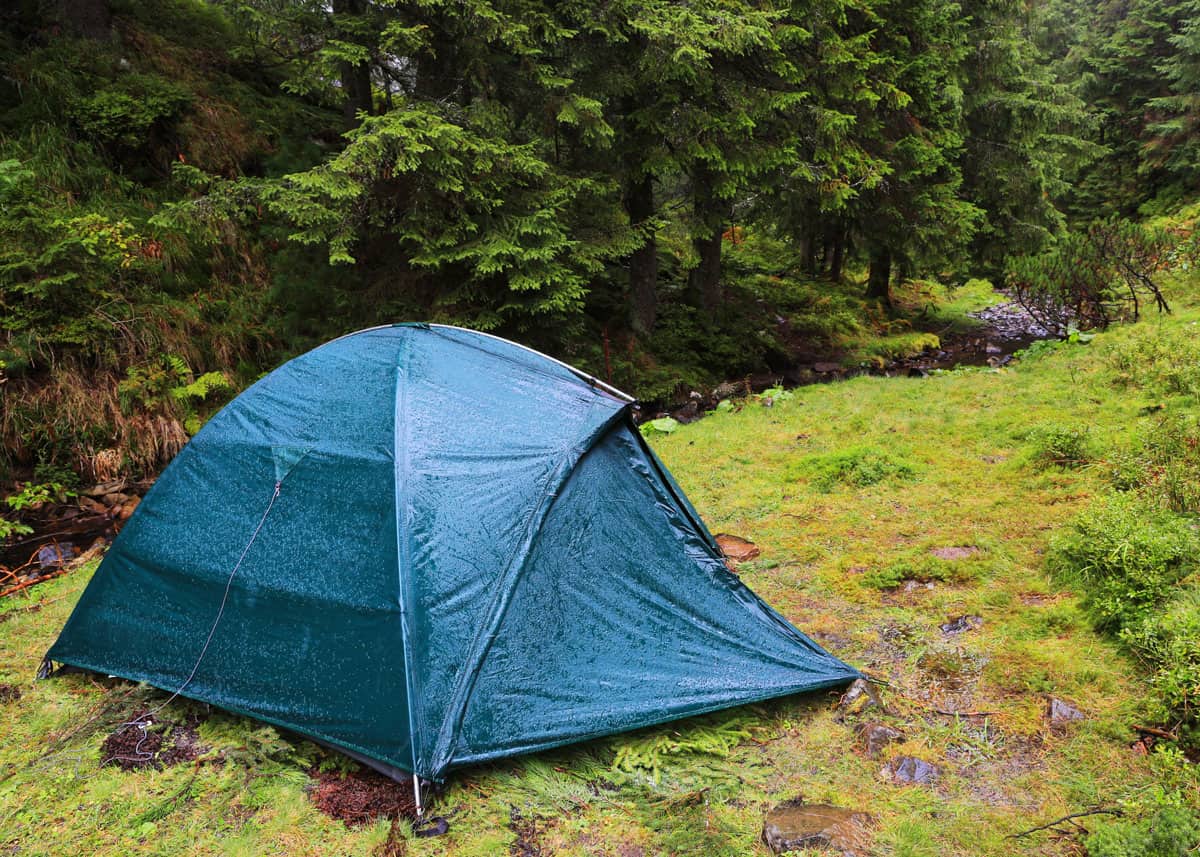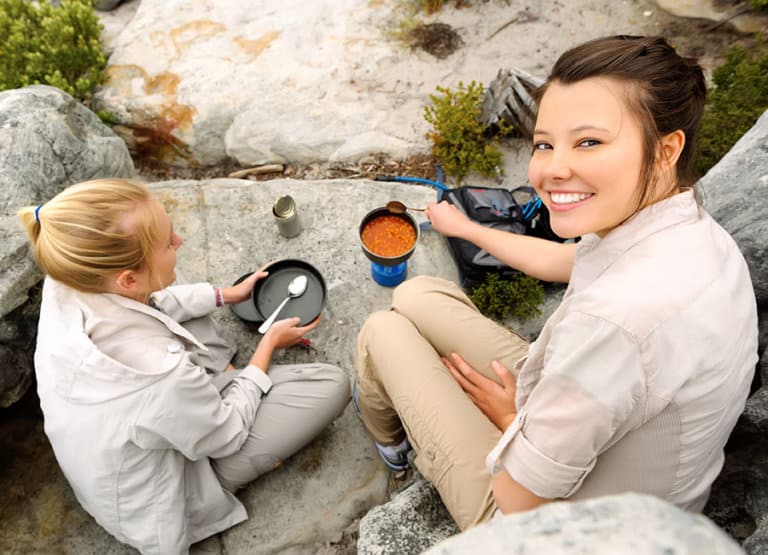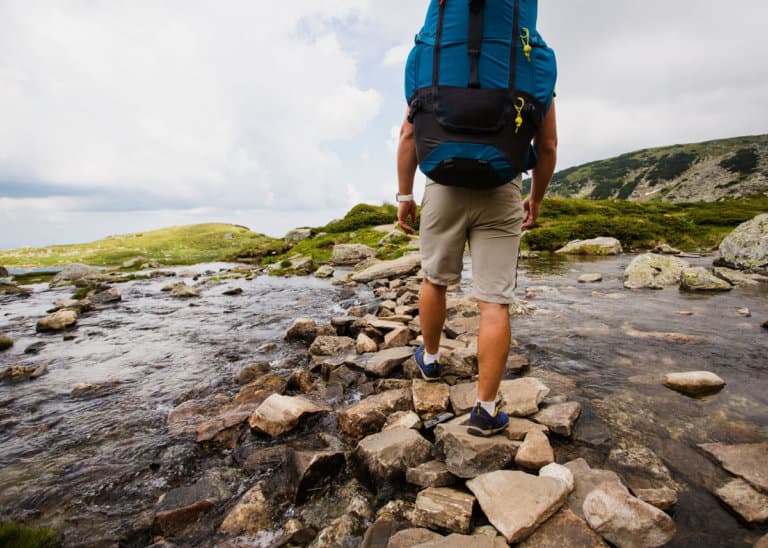Guide to Setting Up a Tent in the Rain (14 Tips)
I know how it feels. You’re just about to leave for a weekend camping trip – and it just started raining. Should you cancel? Not so fast.
In this post, you’ll learn how to set up a tent in the rain. These 14 tips will have you setting up a tent in the rain like a pro.

Setting up a Tent in the Rain: 14 Tips
Does the thought of setting up a tent in the rain stop you from venturing outside on the weekends? Setting up a tent in the rain can be anything from annoying to life-threatening. But it doesn’t have to be.
This article will give you 14 strategies to hack campsite setup in wet weather.
1. Set up a lightweight tarp first
This is probably the most important tip of all. When camping in an area with trees, you can employ this strategy. After you set up the tarp, you can work to put up the tent in relatively dry conditions.
Without a tarp, there is a good chance you can use your rain fly. All you need is some paracord in case the guy lines aren’t long enough.
This tip works best when there are two or more people. However, if you are a solo camper remember that practice makes perfect!
Bonus tip: When in the backcountry, you must still make a bear triad in the rain. Move the food prep area 100 yards away from the tent. Now you have your kitchen area and a shelter under which to make your fire or start your camp stove.

More reading: How to put up a dome tent by yourself
2. Purchase a tent with zip-out panels
Consider getting a tent with zip-out panels. They are better when setting up a tent in the rain than tents that are made of all permeable mesh (without the rain fly).
The panels keep the inside dry. Once the rain fly is attached, the panels can be removed. Voila! The inside of your tent is as dry as it was in your car!
The only downside to this strategy is that the panels add a bit of weight. That is fine for car campers, but backpackers may want to consider another method for setting up a tent in the rain.
3. Pick a good spot
There are a few widely accepted rules when choosing a good spot for setting up a tent in the rain. It is important to select a spot carefully to do as much as possible to keep from getting wet.
The absolute best place to pitch your tent is the lee side of a natural windbreak, like an overhang or a boulder. This means finding shelter in the side away from the wind.
Furthermore, you will want to pick a location on higher ground than the area surrounding it. Avoid low-lying areas, depressions, canyon floors, and washes.
Additionally, do not camp at the bottom of a slope or other area where water seems to gather. Rivers and streams can also be a no-go, because of the possiblity of flooding.
4. Wear appropriate footwear
Setting up a tent in the rain is uncomfortable. Setting up a tent in the rain with inappropriate footwear is downright unbearable! What is considered appropriate depends on the season as well as the situation.
Waterproof hiking boots are acceptable in situations where some rain is expected.
If you expect a ton of rain at your desired camping location, you will want gaiters or waders. Or duct-taped on trash bags. Even if there is no rain while you are out, the grass has the potential to be wet from previous storms.
Rubber boots and waterproof hiking shoes are good for keeping this annoyance at bay.
In the summertime or warm climates, nothing but sandals is necessary! The best sandals for camping are specifically made for outdoor wear. They dry fast, grip wet surfaces, and fit comfortably enough for hiking.

More reading: How to stake a tent properly
5. Roll the fly inside of the tent
When expecting rain, this tip can help keep the inside of your tent dry. While still at home, open the tent and stretch out the rain fly inside.
Although wetness will come through the mesh portions of the tent, the fly will cover the floor of the tent keeping it dry. Then, set up your tent as usual.
6. Buy or make rain gear
Some campers are more concerned with getting wet themselves than getting their gear wet. If this sounds familiar, you will want to buy rain gear and carry it with you at all times.
If you car camp, go ahead and leave it in your vehicle. On day hikes, keep your gear in the front pocket.
When push comes to shove, make your bodily rain protection out of garbage bags! These are great for makeshift waders and ponchos, because they are compact and weigh next to nothing.
7. Purchase a single wall tent
Setting up a tent in the rain is faster and easier with a single-wall tent versus a double-wall tent.
Do you know which kind of tent you have? If there rain fly and tent are separate, you have a double wall. These are the most difficult to set up in the rain because you have to set up the most vulnerable part of the tent first.
Additionally, they take more time and effort to put up. Single wall tents can be erected in one quick go. Why? There is no separate rain fly flapping in the wind while you try to hold it down!
8. Carry a waterproof bivvy
If worse comes to worst when setting up a tent in the rain, having a waterproof bivvy could save the day! Many backcountry explorers always bring a bivvy.
Some consider this item to be one of the essentials because it can come in handy in a variety of situations.
Hopefully, you never find yourself in need of a waterproof emergency bivvy, but what if you did? It is much better to be prepared than to count your regrets cold and wet.
Sometimes the inside of your shelter will get wet. When this happens, you simply set up your sack inside of the tent!
What is a bivvy? Bivvy sack is short for “bivouac sack.” It provides campers and climbers a lightweight emergency weather protection. They are waterproof, durable, and reflect up to 90% of your body heat back to you.
9. Bring a sponge
When setting up a tent in the rain doesn’t go as planned, water removal is a necessity. If you bring a large sponge, you can sop the rain out.
A small shovel is always good to carry, and those in the backcountry should have one on hand already for restroom use.
A shovel can be used to fill in any puddles or divert any newly formed streams across your campsite. Alternatively, you can use quick-dry micro-towels to wipe out any water.
10. Wait out the deluge
Even during a heavy daylong downpour, there are times when the wall of water lessens or stops completely. If you simply wait you might avoid setting up a tent in the rain altogether.
Some backcountry campers wait it out under a tree, squatting by their gear. However, others warn against taking shelter under trees in a storm due to lightning and falling limbs.
If you have a lightweight tarp, you can set that up and take refuge underneath. Make some hot chocolate or camping coffee and wait it out in style!

11. Get a rain cover for your backpack
All smart backpackers know once the stuff gets wet you are generally in trouble. If it is cold, there is the chance to freeze.
In the mountains, a blue sky day can quickly give way to violent thunderstorms. That is why it is of utmost importance to get a rain cover for your backpack. Dry materials make setting up a tent in the rain easier.
Pro Tip: The absolute most important things to keep dry are clothing and your sleeping bag, so pack around them accordingly.
You might want to bring a small camping heater to dry things out and take the chill off.
12. Try to set up camp in the daylight
Even though this seems like a no-brainer, it can help when setting up a tent in the rain. Darkness is just another factor adding to an already thorny task.
While it is true that headlamps work hands-free wonders, it is also true that your line of vision is extremely reduced. It could be easy to miss the signs of a good camping spot.
Even worse, you could end up in a dangerous area if you can’t decipher the landscape at night. Add precipitation, and seeing even 2 feet in front of you can be next to impossible.
Don’t forget, you won’t have the help of the moon if it’s raining.
13. Make a plan before you go
This will turn out to be one of the most helpful tips on the list. To be prepared, it is important to make a plan before you try setting up a tent in the rain.
This includes deciding which of these tips and strategies you will utilize.
It also means deciding how to best pack your backpack or car to have easy access to everything you need, as you need it. Go over this blueprint with your camping partners until everyone feels comfortable executing.
These camping gadgets might come in handy on your wet camping trip.
14. Try out your plan before you go
Practice is required to be truly prepared for setting up a tent in the rain. There are plenty of things to do! Go ahead and try out your rain gear before you go out. Make sure you know how to put it on quickly and correctly.
If you are going the budget route, create your makeshift rain clothing until you can do it right the first time. Whether solo or with a partner, practice hanging the tarp.
Make it a game, and see how quickly you can do it! Additionally, pitch your tent in the method you decide and aim for speed and accuracy. When you think you are ready, set up some sprinklers and let the real trial runs begin!
You can still camp with just your tarp if something happens to your tent.
Here are three possible setups.
Setting up a Tent in the Rain Doesn’t Have to be a Pain
Although setting up camp in the rain gets a bad rap, it doesn’t have to be an experience you dread.
With some strategy and preparation, anyone can learn how to make camp in wet weather. Whether it’s pouring rain or only misting, these 15 tips and hacks will help make any outdoor setup dry and comfortable!
Have you set up your tent in the rain? What worked (or didn’t work) for you? Join me in the comments!








Great advice. We learned these things, every summer while raising our kids (3). No regrets.
I have set up a tent in the rain a million times. Your tips were great thank you so much.
I really love to see the detailed article on setting up a tent in the rain. I never thought someone will do that. Thanks Dena for sharing this.